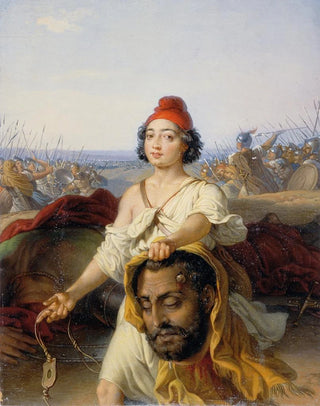Art print | David with Goliath's Head - Johann Peter Krafft


View from behind

Frame (optional)
The artwork "David with the head of Goliath" by Johann Peter Krafft is a striking depiction of an iconic moment from biblical mythology. This painting, illustrating the young shepherd's victory over the giant Goliath, immerses the viewer in a universe where bravery and faith intersect. The scene is imbued with dramatic intensity that captures attention and prompts reflection on the nature of triumph. Krafft, as an artist, manages to transcend the simple narrative to offer a representation that is both symbolic and emotional. His mastery of light and shadow, as well as the expression of the characters, invites a deep immersion into this ancient struggle between good and evil.
Style and uniqueness of the work
Krafft's style, rooted in neoclassicism, is distinguished by its precision and attention to detail. In "David with the head of Goliath," every element is carefully considered to reinforce the message of the artwork. David's posture, both triumphant and humble, evokes an inner strength that goes beyond mere physicality. The colors, chosen with care, create a striking contrast between the innocence of the young hero and the brutality of his opponent. The background, although secondary, contributes to the dramatic atmosphere of the scene, adding a dimension of depth that enhances the visual impact. This work transcends time and space, allowing the viewer to feel the raw emotion of this decisive moment.
The artist and his influence
Johann Peter Krafft, born in 1780, was an artist whose work is set against the tumultuous backdrop of post-revolutionary Europe. His artistic journey was marked by a desire to redefine the aesthetic standards of his era. Influenced by the great masters of the past, he succeeded in creating a visual language that is uniquely his own, blending tradition and innovation. Krafft, as a portraitist and history painter, was able to capture the spirit of his time while focusing on universal themes such as struggle, sacrifice, and redemption. His ability to evoke

Matte finish

View from behind

Frame (optional)
The artwork "David with the head of Goliath" by Johann Peter Krafft is a striking depiction of an iconic moment from biblical mythology. This painting, illustrating the young shepherd's victory over the giant Goliath, immerses the viewer in a universe where bravery and faith intersect. The scene is imbued with dramatic intensity that captures attention and prompts reflection on the nature of triumph. Krafft, as an artist, manages to transcend the simple narrative to offer a representation that is both symbolic and emotional. His mastery of light and shadow, as well as the expression of the characters, invites a deep immersion into this ancient struggle between good and evil.
Style and uniqueness of the work
Krafft's style, rooted in neoclassicism, is distinguished by its precision and attention to detail. In "David with the head of Goliath," every element is carefully considered to reinforce the message of the artwork. David's posture, both triumphant and humble, evokes an inner strength that goes beyond mere physicality. The colors, chosen with care, create a striking contrast between the innocence of the young hero and the brutality of his opponent. The background, although secondary, contributes to the dramatic atmosphere of the scene, adding a dimension of depth that enhances the visual impact. This work transcends time and space, allowing the viewer to feel the raw emotion of this decisive moment.
The artist and his influence
Johann Peter Krafft, born in 1780, was an artist whose work is set against the tumultuous backdrop of post-revolutionary Europe. His artistic journey was marked by a desire to redefine the aesthetic standards of his era. Influenced by the great masters of the past, he succeeded in creating a visual language that is uniquely his own, blending tradition and innovation. Krafft, as a portraitist and history painter, was able to capture the spirit of his time while focusing on universal themes such as struggle, sacrifice, and redemption. His ability to evoke






